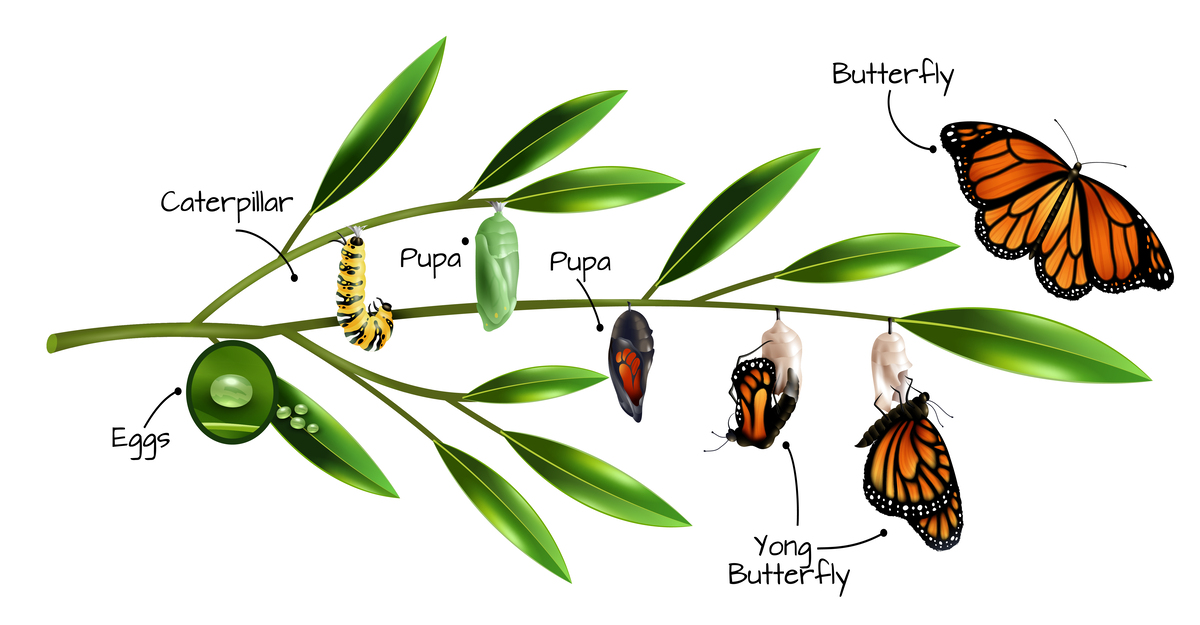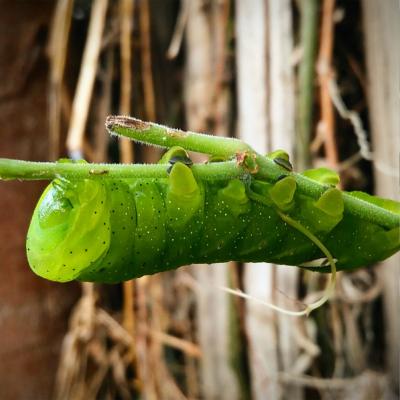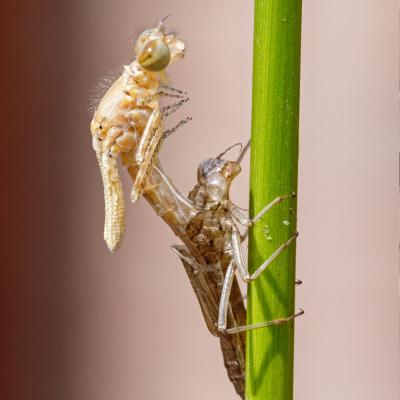Anúncios
The metamorphosis of insects is a transformative process that illustrates nature’s ingenuity in adaptation and survival. With life cycles divided into distinct stages, insects take advantage of each phase in a specialized way. This strategy results in a dominant and resilient presence in varied ecosystems.
Studying metamorphosis allows us to understand the depth of evolutionary adaptations in insects. In addition to revealing impressive biological aspects, this process shows how small creatures shape large ecological dynamics. Thus, metamorphosis stands out as an essential factor for the evolutionary success of these organisms.
Anúncios

Types of Metamorphosis: Complete and Incomplete
Complete metamorphosis includes four stages: egg, larva, pupa, and adult. Each phase presents specific functions that help the insect survive. This cycle is common in butterflies, beetles, and flies.
In incomplete metamorphosis, insects go through three stages: egg, nymph, and adult. The nymph resembles the adult but is still developing. Examples include grasshoppers and cockroaches.
These two forms evolved to meet different ecological demands. While one favors radical changes, the other maintains functional continuity between phases. Both represent effective adaptations to the environment.
The type of metamorphosis influences behavior, morphology, and occupied habitats. This directly contributes to the diversity and distribution of insects in nature. Each pattern offers unique survival advantages.
Ecological Advantages of Metamorphosis
Metamorphosis allows for a division of functions between life stages. This reduces food competition between larvae and adults. As a result, insects make better use of environmental resources.
Metamorphic insects can also occupy different habitats throughout the cycle. Aquatic larvae and terrestrial adults are a common example. This flexibility increases their chances of ecological success.
Another benefit is increased functional specialization. While the larva focuses on growth and feeding, the adult prioritizes reproduction and dispersal. This separation improves the ecological efficiency of each phase.
Moreover, metamorphosis promotes interaction with other species. Pollinators, decomposers, and predators play vital roles in ecosystems. All of this is made possible by bodily and behavioral transformations.
Morphological and Physiological Adaptations
During metamorphosis, the insect’s body undergoes significant structural changes. Tissues are reorganized and new structures are formed. This allows adaptation to new ecological functions.
Hormones such as ecdysone and juvenile hormone regulate these transformations. They control growth, molting, and cellular differentiation. This precise regulation is vital for the process’s success.
The formation of wings, compound eyes, and reproductive organs occurs in the adult phase. These structures allow the insect to interact more effectively with the environment. They also ensure success in reproduction and dispersal.
Each stage presents physiology adapted to its needs. Larvae have efficient digestive systems, adults prioritize reproductive systems. This ensures maximum efficiency at each stage of the life cycle.
Survival and Defense Strategies

Many insects use metamorphosis as a defense strategy. Larvae can camouflage or mimic leaves and twigs. Adults develop warning coloration or predator mimicry.
Additionally, some insects enter diapause during the pupal stage. This metabolic pause protects the organism from adverse conditions. Thus, the insect only emerges when the environment is favorable.
Stage specialization also helps avoid predators. Since larvae and adults occupy different niches, predation pressure is split. This increases overall survival chances.
Some insects also have active defense mechanisms. Spines, toxins, and escape behaviors are common in certain species. These strategies reinforce the effectiveness of metamorphosis as an evolutionary adaptation.
Insect Metamorphosis is one of Nature’s Most Fascinating Phenomena
Insect metamorphosis is one of the most fascinating phenomena in nature, demonstrating the incredible adaptability and resilience of these creatures. This process, which involves a series of developmental stages that transform an insect from an egg to an adult, plays a crucial role in their survival and evolutionary success. By undergoing metamorphosis, insects can explore different ecological niches, reduce competition for resources, and increase their reproductive success. This remarkable strategy has allowed insects to thrive in countless environments, contributing to their status as the most diverse group of organisms on Earth.
The study of insect metamorphosis not only provides insights into the complexities of life cycles but also illuminates the evolutionary pressures that have shaped these processes over millions of years. Understanding how and why insects undergo such dramatic transformations can help researchers uncover the underlying mechanisms of evolution and adaptation. As we delve deeper into the intricate nuances of insect metamorphosis, we can appreciate the profound impact this strategy has on ecological dynamics and species survival.
How Insect Metamorphosis Works: A Look at Life Cycle Changes
Insect metamorphosis generally occurs in two main forms: complete metamorphosis (holometabolism) and incomplete metamorphosis (hemimetabolism). Complete metamorphosis involves four distinct stages: egg, larva, pupa, and adult. In contrast, incomplete metamorphosis consists of three stages: egg, nymph, and adult. Each stage presents unique characteristics and adaptations that allow insects to thrive in their respective environments.
During the egg stage, the fertilized ovum develops into a larva. This larval stage is often the most critical for growth and development, as it is during this time that the insect feeds voraciously to accumulate energy and nutrients for its transformation. Larvae can take many forms, from caterpillars to grubs, and are often specialized for different ecological functions. For example, some larvae are herbivores, while others may be predators or scavengers, allowing them to explore diverse food sources.
The next stage, the pupa, is where the most dramatic changes occur. This stage is often characterized by a period of dormancy, during which the insect undergoes extensive reorganization of its body structure. Hormonal changes trigger the breakdown of larval tissues and the formation of adult structures such as wings and reproductive organs. This process can take several weeks to months, depending on the species and environmental conditions.
Finally, the adult stage emerges, often referred to as the imago. At this point, the insect is fully formed and capable of reproduction. The adult stage is typically shorter-lived than the larval stage, as the main focus shifts to mating and dispersal. This complex life cycle allows insects to adapt to changing environments, reduce competition, and maximize their reproductive success.
Insect Metamorphosis as a Strategy for Success

Insect metamorphosis offers numerous advantages that contribute to the evolutionary success of these organisms. One of the main benefits is the ability to exploit different ecological niches at various stages of life. For example, while the larval stage may focus on feeding and growth, the adult stage may prioritize reproduction and dispersal. This division of labor allows insects to minimize competition for resources and maximize their chances of survival.
Furthermore, metamorphosis allows insects to adapt to changing environmental conditions. For example, during periods of scarcity, larvae may enter a state of diapause, pausing their development until conditions improve. This ability to delay growth and reproduction can be crucial for survival in unpredictable environments. Additionally, the distinct life stages allow for specialization, with larvae and adults evolving different traits and behaviors that enhance their survival in their respective habitats.
Another advantage of insect metamorphosis is the potential to increase genetic diversity. As insects undergo metamorphosis, they may experience recombination and genetic variation, leading to the emergence of new traits that can improve their adaptability. This genetic diversity is vital for the long-term survival of species, as it allows populations to respond to environmental changes and pressures.
Lastly, the dramatic transformations associated with metamorphosis can serve as a defense mechanism against predators. Many larvae possess camouflage or other adaptations that help them avoid detection, while adults may develop warning coloration or mimicry to deter potential threats. This ability to change form can enhance an insect’s chances of survival in a world full of predators and environmental challenges.
How Insect Metamorphosis Enhances Ecological Success
Insect metamorphosis plays a significant role in enhancing ecological success through various mechanisms. One key aspect is the ability to occupy different ecological roles at different life stages. For example, while larvae may be herbivores, adults may be pollinators or predators. This versatility allows insects to contribute to ecosystem functions such as pollination, decomposition, and nutrient cycling, increasing biodiversity and ecosystem health.
Resource Utilization: Different life stages allow insects to explore a wide range of resources, reducing competition and increasing their chances of survival. Larvae may feed on plant material, while adults may access nectar or other food sources.
Predator-Prey Dynamics: The distinct life stages of insects can influence predator-prey interactions. For example, larvae may be more vulnerable to predation, while adults may have developed defenses that help them escape predators.
Pollination Services: Many adult insects, particularly those undergoing complete metamorphosis, play crucial roles in pollination. Their ability to feed on nectar while transferring pollen between flowers enhances plant reproduction and biodiversity.
Decomposition and Nutrient Cycling: Some insect larvae are essential decomposers, breaking down organic matter and recycling nutrients back into the ecosystem. This process contributes to soil health and fertility, benefiting plant growth.
Adaptive Strategies: The ability to undergo metamorphosis allows insects to adapt to changing environmental conditions. For example, in response to climate change, some species may alter their development timing or reproductive strategies to better align with available resources.
Habitat Diversification: Insects that undergo metamorphosis can occupy multiple habitats over their life cycle. This ability to explore different environments increases their ecological success and resilience.
In summary, insect metamorphosis significantly enhances ecological success by enabling these organisms to occupy diverse roles, adapt to changing conditions, and contribute to ecosystem functions. This adaptability is a key factor in the survival and proliferation of insects worldwide.
Did You Enjoy Learning about Insect Metamorphosis as an Evolutionary Success Strategy?
Insect metamorph
osis is a captivating topic that reveals the intricacies of nature’s evolutionary strategies. Understanding how insects undergo such profound transformations not only highlights their adaptability but also underscores the importance of biodiversity in maintaining healthy ecosystems. By exploring the various stages of metamorphosis, we gain a deeper appreciation for the resilience of these remarkable creatures.
As we continue to learn about insect metamorphosis and its role in ecological dynamics, we are reminded of the interconnectedness of life on Earth. The more we understand these processes, the better equipped we are to protect and conserve the diverse species that share our planet.
Frequently Asked Questions
What is insect metamorphosis?
Insect metamorphosis is the change they undergo from egg to adult stage. This can include several steps such as larva and pupa.
Why is metamorphosis a successful strategy?
Insect metamorphosis helps insects adapt to different environments. This process allows them to explore more resources and survive better.
What are the types of insect metamorphosis?
There are two main types: complete and incomplete. In the complete type, there are four stages. In the incomplete type, there are three.
How does metamorphosis help insect survival?
During insect metamorphosis, they change their body and habits. This helps avoid predators and compete for food more effectively.
Is insect metamorphosis a unique feature?
No, other animals also go through changes. But insect metamorphosis is one of the most diverse and adaptive.
